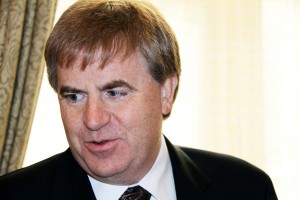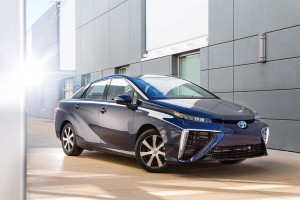Enjoy cheap gas while you can, says Bob Carter, the head of U.S. automotive operations for Toyota. Like all good things, it “eventually” will come to an end.
The collapse of gas prices was the talk of the North American International Auto Show during this week’s media previews, and senior industry officials universally said that this unexpected shift has both its benefits and challenges.
Consumers have more money to spend, but they’re also asking for the sort of big, powerful vehicles that could make it difficult to meet the upcoming, 54.5-mile per gallon Corporate Average Fuel Economy, or CAFE, standards that will take effect in 2025.
Several senior executives, including FCA Chief Executive Sergio Marchionne, said they are looking forward to the required industry-government review, scheduled for 2017, and may press to have the fuel rules either delayed or rolled back. But not all manufacturers are hoping for such a reprieve.
“We’re clearly staying the course,” said Carter, during an interview with TheDetroitBureau.com, stressing that the Japanese giant is not rethinking its heavy push into hybrids and other high-mileage technologies.
Toyota isn’t ignoring current market trends. It brought to the Detroit Auto Show its completely redesigned Toyota Tacoma, a midsize pickup it dubbed “The Beast.” But also on display was the Toyota Mirai, the hydrogen fuel-cell vehicle it will launch in the U.S. by mid-year.
Carter said his company has high hopes for hydrogen technology – which has several advantages over battery-electric vehicles, including longer range and fast refueling times. That led Toyota to drop its only pure battery-electric model, the RAV4-EV.
“Mirai is the long-term play,” the executive vice president asserted, though he wouldn’t take a stab at projecting possible sales volumes.
One reason is that Mirai – and competing fuel-cell vehicles from Honda and Hyundai – will be limited to the Southern California region where the few current hydrogen filling stations are located. But that availability is expected to grow over the next decade. California lawmakers have approved funding for a statewide infrastructure, and both Toyota and Honda have committed their own money to setting up public pumps.
Toyota also announced earlier this month that it would make its hundreds of hydrogen patents available at no charge to competitors, hoping that will help get even more products onto the market. The bet is that with increased vehicle sales energy providers will want to serve the emerging market.
(Toyota maintains post atop midsize mountain with Tacoma. For more, Click Here.)
Carter conceded Toyota my eventually have to come back with a battery-electric vehicle. The reality, he said, is that a variety of different powertrains solutions are likely to be needed until one clearly emerges as the best.
Toyota isn’t entirely averse to battery power. Its Prius has dominated the hybrid segment, but except for a plug-in version, the Prius “family” relies on older – but time-tested nickel-metal, rather than newer lithium-ion, batteries.
(Click Here for details about Lexus new track and street performance cars.)
Prius sales actually dipped a bit last year, something Toyota hopes to resolve with a new model now moving towards launch.
Whether Prius has also suffered due to the fuel price plunge is open to debate. But Carter said Toyota can wait that out.
(To see why GM is forecasting a profit for 2015, Click Here.)
“We’re anticipating this suppressed level of oil pricing will sustain itself through 2015,” he suggested, “But eventually, (higher prices) will come back.” And that should have American motorists once again shifting their buying habits.



Toyota like all major auto makers actually has no choice in the matter because the fines that would be passed on to consumers would kill their sales. Consumer’s are going to pay thousands of dollars more every year for the pulled-from-his-orifice Obama 54.5 mpg decree which is not based in any way shape or form on science or currently available technology.